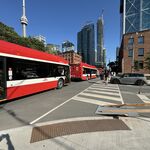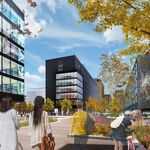I am not sure the frequency of GO RER, but I assume 10' for a transfer to GO, 5' from bus to TTC rail, and 3' from TTC rail to rail - just to see the sensitivity.
A. UTSC to Dundas Station via Bus, Lakeshore East RER: (all existing routes)
1 - 198 Express from UTSC to Guildwood GO Station: 10 minutes (+10' transfer)
2 - Guildwood GO Station to Union GO Station: 25 minutes (+5' transfer)
3 - Union Station to Dundas Station: 3 minutes
Total: 53 min
B. UTSC to Dundas Station via Bus, Line 2 (assuming proposed B-D extension to Sheppard)
1 - 38 Highland Creek to Scarborough Centre Station: 17 minutes (+5' transfer)
2 - Scarborough Centre Station to Bloor-Yonge Station: 30 minutes (+3' transfer)
3 - Bloor-Yonge Station to Dundas Station: 4 min
Total: 59 min
C. UTSC to Dundas Station via Bus, Line 3 and Stouffville RER/SmartTrack (assuming SRT exists and SmartTrack)
1 - 36 TTC Bus to Centennial Station: 13 minutes (+5' transfer)
2 - Centennial Station to Ellesmere Station: 7 min (36 km/h) (+10' transfer)
3 - Ellesmere Station to Union Station: 23 min (+5' transfer)
4 - Union Station to Dundas Station: 3 min
Total: 66 min
C'. UTSC to Dundas Station via Bus, Stouffville RER/SmartTrack (assuming no SRT or B-D extension and SmartTrack)
1 - 36 TTC Bus to Ellesmere Station: 26 minutes (+10' transfer)
2 - Ellesmere Station to Union Station: 23 min (+5' transfer)
3 - Union Station to Dundas Station: 3 min
Total: 67 min
C". UTSC to Dundas Station via Bus, Line 2 and Stouffville RER/SmartTrack (assuming proposed B-D extension to Sheppard and SmartTrack)
1 - 38 Highland Creek to Scarborough Centre Station: 17 minutes (+5' transfer)
2 - Scarborough Centre Station to Kennedy: 10 minutes (+10' transfer)
3 - Kennedy to Union Station: 19 minutes (+5' transfer)
4 - Union Station to Dundas Station: 3 min
Total: 69 min
D. UTSC to Dundas Station via Bus, Line 3 continuous to Line 1 (assuming Eglinton elevated instead of B-D extension)
1 - TTC Bus to Centennial Station: 13 minutes (+5' transfer)
2 - Centennial Station to Yonge-Eg Station: 34 min (35 km/h) (+3' transfer)
3 - Bloor-Yonge Station to Dundas Station: 4 min
Total: 59 min
A few things to learn.
- Connecting Eglinton LRT to SRT is just as effective as extending Line 2, but at $1B less cost.
- GO RER (on all lines) is just as important or more so than SmartTrack only on the Markham line. For this travel pattern, GO Lakeshore is the best option - but lack of fair integration would mean it doesn't get used.
- It would be interesting to see what the result is for a travel pattern from Malvern (another large node in Scarborough) to Dundas.




